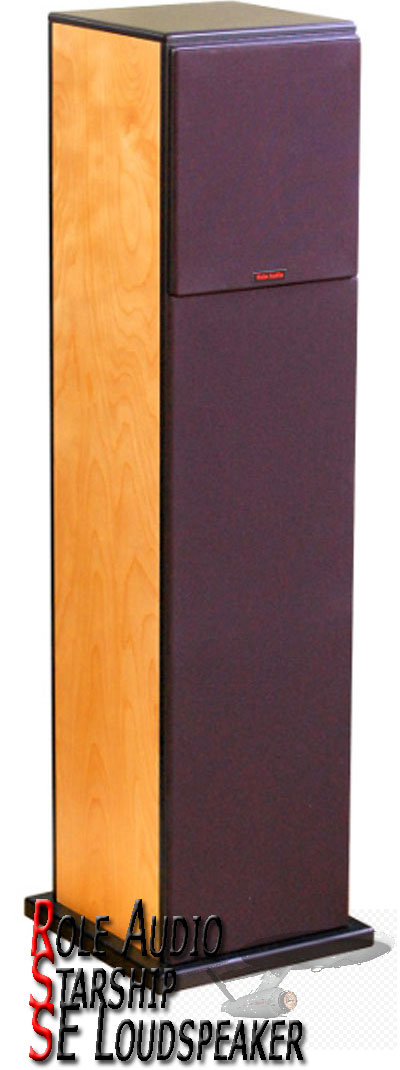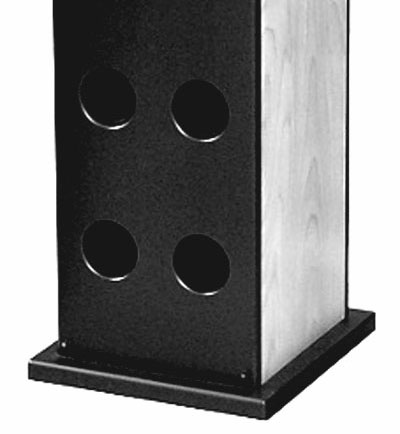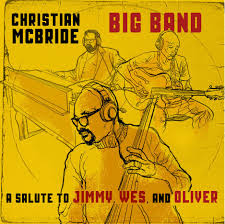Role Audio Starship SE Loudspeaker by Terry London

 Over the last ten years, I have enjoyed reviewing five loudspeaker designs from the “twin” companies of Role Audio and NSMT Loudspeakers, including stand mount and floor-standers, from the creative mind of Erol Ricketts. Mr. Ricketts is the CEO and chief designer of these companies located in Research Triangle, North Carolina. The company, Role Audio, centers on smaller two-way speakers for either desktop use or smaller acoustic spaces. His other company, NSMT Loudspeakers, is where the larger and more expensive floor-standing models are designed and manufactured. All of his loudspeakers are hand-built of the finest materials and offer very innovative approaches regarding driver materials, crossover designs, and transmission line loading into their cabinets. This review’s subject is the largest and most expensive model under the Role Audio banner, the Starship SE, which retails for $7,995. Last year, I had placed Mr. Ricketts, NSMT Loudspeakers Model 100 on the Stereo Times “Most Wanted Components of the Decade” list and purchased the pair because of how superlative their performance was in my vast listening space.
Over the last ten years, I have enjoyed reviewing five loudspeaker designs from the “twin” companies of Role Audio and NSMT Loudspeakers, including stand mount and floor-standers, from the creative mind of Erol Ricketts. Mr. Ricketts is the CEO and chief designer of these companies located in Research Triangle, North Carolina. The company, Role Audio, centers on smaller two-way speakers for either desktop use or smaller acoustic spaces. His other company, NSMT Loudspeakers, is where the larger and more expensive floor-standing models are designed and manufactured. All of his loudspeakers are hand-built of the finest materials and offer very innovative approaches regarding driver materials, crossover designs, and transmission line loading into their cabinets. This review’s subject is the largest and most expensive model under the Role Audio banner, the Starship SE, which retails for $7,995. Last year, I had placed Mr. Ricketts, NSMT Loudspeakers Model 100 on the Stereo Times “Most Wanted Components of the Decade” list and purchased the pair because of how superlative their performance was in my vast listening space.
 When I was putting together my notes to write this review, it became apparent that all the loudspeakers – that I thought were the most natural and musical in their performance – mainly use soft-dome silk/textile tweeters and midrange drivers composed of either carbon or natural pulp materials. The most critical aspect in the reproduction of music is timbre, tonality, and the unique colors of different acoustic instruments. Yes, I have reviewed/owned speakers that used AMT, ribbon, and diamond drivers that were excellent in their performance. However, for long-term listening pleasure, I tend to migrate back to speakers using drivers composed of natural materials. Tekton Design, Harbeth Audio, and Devore Fidelity would be examples of their designers using natural fiber drivers that offer this realistic and beautiful rendering of voices and instruments’ harmonics. Just think, in Wilson Audio’s new reference model, the Chronosonic XVX loudspeaker, which retails for $329,000, they got rid of their hard dome Beryllium tweeter and replaced it with a silk dome design. Back to the future! When I interviewed Mr. Ricketts for the Model 100 review, he shared that he had experimented with scores of different drivers composed of various metals, polymers, and ceramic materials but always came back to his “ear” selected silk/textile, carbon, and natural pulp drivers because of their rendering of tonality and colors.
When I was putting together my notes to write this review, it became apparent that all the loudspeakers – that I thought were the most natural and musical in their performance – mainly use soft-dome silk/textile tweeters and midrange drivers composed of either carbon or natural pulp materials. The most critical aspect in the reproduction of music is timbre, tonality, and the unique colors of different acoustic instruments. Yes, I have reviewed/owned speakers that used AMT, ribbon, and diamond drivers that were excellent in their performance. However, for long-term listening pleasure, I tend to migrate back to speakers using drivers composed of natural materials. Tekton Design, Harbeth Audio, and Devore Fidelity would be examples of their designers using natural fiber drivers that offer this realistic and beautiful rendering of voices and instruments’ harmonics. Just think, in Wilson Audio’s new reference model, the Chronosonic XVX loudspeaker, which retails for $329,000, they got rid of their hard dome Beryllium tweeter and replaced it with a silk dome design. Back to the future! When I interviewed Mr. Ricketts for the Model 100 review, he shared that he had experimented with scores of different drivers composed of various metals, polymers, and ceramic materials but always came back to his “ear” selected silk/textile, carbon, and natural pulp drivers because of their rendering of tonality and colors.
Starship SE speakers’ demo pair were clad in black satin front and back with red birch veneer on the sides and were quite attractive. They sit on satin black plinths, with high-quality spikes provided. The Starship SE speakers’ dimensions are height 44″ x width 10″ x depth 11″. Each speaker weighs 55 pounds. There is a mounting plate at the top of the front baffle where the array of five drivers sits; lower down towards the bottom are the four ports for the quad transmission lines. On the cabinet, around the back, a pair of high-quality speaker wire binding posts allow one to bi-wire the speaker. I found no difference in the Starship SE’s performance using a single run of speaker wire and quality jumpers. The pair of Starship SEs went into my smaller system. They were positioned four feet off the front wall, three feet off the sidewalls, and six feet apart. A slight toe-in just angled on the outside of my ears locked in center imaging. I experimented with leaving the black grills on or off for better sound performance and decided I could not hear a difference. Therefore, I left the grills on because I thought the speakers looked elegant and sleek with them attached. They were driven with a variety of solid-state and tube-based amplifiers and preamplifiers I had on hand. Before I get into the details of the performance of this speaker, which turned out to meet my lofty expectations based on my past experience of reviewing four other models that all delivered superlative music in my systems designed by Ricketts, I asked him the following questions regarding what he was trying to accomplish with his Starship SE design and what makes this design special/different than other two-way monitors?
What was your design goal in creating the Starship SE model?
 “The goal for the Starship SE was to design the seemingly contradictory performance aesthetics of powerful dynamics and superb imaging and sound-staging in a compact loudspeaker. As the flagship of the Kayak series of two-way speakers, the Starship SE design builds on what has been learned designing the single short transmission line Windjammer and the dual short transmission line Enterprise speakers and the principle of not using crossovers in the fundamental frequency range of instruments. My design approach is to use an unprecedented four transmission lines (Quad TL) driven by four small carbon fiber four-inch drivers and a one-inch soft dome tweeter arranged as a two-way, time coherent, point source driver array.”
“The goal for the Starship SE was to design the seemingly contradictory performance aesthetics of powerful dynamics and superb imaging and sound-staging in a compact loudspeaker. As the flagship of the Kayak series of two-way speakers, the Starship SE design builds on what has been learned designing the single short transmission line Windjammer and the dual short transmission line Enterprise speakers and the principle of not using crossovers in the fundamental frequency range of instruments. My design approach is to use an unprecedented four transmission lines (Quad TL) driven by four small carbon fiber four-inch drivers and a one-inch soft dome tweeter arranged as a two-way, time coherent, point source driver array.”
How can it be a point source and be dynamically powerful?
“As the ideal point source, the single full-range driver provides magical imaging and sound-staging but often disappointing high-frequency performance. Two-way coincident driver array speakers, where the tweeter is mounted in the throat of the woofer, solve the high-frequency problem of the single driver full-range speaker, but only up to a point. At high volume levels, frequencies produced by the tweeter are subjected to Doppler effects caused by the rapid movement of the surrounding woofer cone. My four transmission line five-driver concentric array is a solution to the high volume frequency problems of the single driver and concentric driver designs because the transmission line design causes significantly reduced cone motion at high volume levels, avoiding the Doppler effects, while providing all the benefits of a point source design. The use of four small drivers and transmission lines used in the Windjammer and Enterprise speakers, which are known for their bass prowess, means the Starship SE can be compact and produce very powerful dynamics.”
How can it be efficient and have a high impedance, which is an easy load for amplifiers, especially tube amplifiers?
“The four drivers are wired to act as a single driver with the combination of series and parallel wiring so that the current flows through them as it would a single driver. The result is a high impedance load with a minimum DCR (direct current resistance) of 10 Ohms and a relatively high sensitivity of 93 dB.”
How can the Starship SE render the most delicate subtleties and be dynamically powerful?
 “The transmission design reduces distortion at high volume because it causes reduced cone motion of the drivers, allowing the drivers to more accurately reproduce subtleties and recorded ambient sounds even at high volume. As noted before the five-driver point source driver array has the exceptional imaging and sound-staging of point source designs without the high frequency and high volume limitations. The Starship SE’s design is enhanced by a minimalist, first-order (6 dB), transient perfect crossover- a single air core inductor for the woofers and a single capacitor for the tweeter. The use of four small drivers means the speaker’s response is fast with great image focus and micro-dynamics resolution. Macro-dynamic performance and clarity are improved by routing the four transmission line ports through the front baffle, which reduces bass interaction with the front wall behind the speaker and room boundaries.”
“The transmission design reduces distortion at high volume because it causes reduced cone motion of the drivers, allowing the drivers to more accurately reproduce subtleties and recorded ambient sounds even at high volume. As noted before the five-driver point source driver array has the exceptional imaging and sound-staging of point source designs without the high frequency and high volume limitations. The Starship SE’s design is enhanced by a minimalist, first-order (6 dB), transient perfect crossover- a single air core inductor for the woofers and a single capacitor for the tweeter. The use of four small drivers means the speaker’s response is fast with great image focus and micro-dynamics resolution. Macro-dynamic performance and clarity are improved by routing the four transmission line ports through the front baffle, which reduces bass interaction with the front wall behind the speaker and room boundaries.”
Each of my music selections were chosen to evaluate three different aspects of the Starship SE speaker’s performance: 1) Tonality/timbres/colors of voices and instruments regarding how pure and organic this speaker could reproduce this unique quality that is necessary to allow an emotional connection to take place when listening to recorded music. This allows the listener to relax into the music and the feelings that the musicians are trying to convey are experienced at a high level. 2) Could this small footprint speaker deliver realistic levels of macro-dynamics, transient speed, and powerful, accurate extended bass frequencies at high dB volume levels. 3) Would this speaker create soundstaging depth and dimensionality with the precise location of three-dimensional images that are expected from a reference level two-way design. This is the “magical disappearing act” where the speakers are gone, and an illusion of a soundstage is just floating in front of you in your listening space.
 I am so fortunate that I heard Muddy Waters many times in the small clubs in Chicago when I was in my twenty’s and “clubbing” around the jazz and blues venues. His album “Folk Singer,” recorded in 1963 by Chicago-based Chess Records, has one of the most pristine presentations of his unique voice, along with the exceptional tonality of a very young Buddy Guy’s guitar playing. I was truly mesmerized by the spot-on tone colors of Muddy’s voice, along with the power he generated when he would “shout” a particular phrase over the beat. This album also creates, if the system is up to it, a tremendously open and layered soundstage where each musician can easily be imagined where they were located in the studio the day of the recording. The Starship SE speaker was a conduit that allowed the above characteristics to float out into my listening space. The density of the colors of Water’s voice was vivid and nailed what I remember many years ago was what he sounded like in small venues with very little amplification.
I am so fortunate that I heard Muddy Waters many times in the small clubs in Chicago when I was in my twenty’s and “clubbing” around the jazz and blues venues. His album “Folk Singer,” recorded in 1963 by Chicago-based Chess Records, has one of the most pristine presentations of his unique voice, along with the exceptional tonality of a very young Buddy Guy’s guitar playing. I was truly mesmerized by the spot-on tone colors of Muddy’s voice, along with the power he generated when he would “shout” a particular phrase over the beat. This album also creates, if the system is up to it, a tremendously open and layered soundstage where each musician can easily be imagined where they were located in the studio the day of the recording. The Starship SE speaker was a conduit that allowed the above characteristics to float out into my listening space. The density of the colors of Water’s voice was vivid and nailed what I remember many years ago was what he sounded like in small venues with very little amplification.
 The next album up was the new recording of the bass player Christian McBride, entitled “Big Band-For Jimmy” (Jimmy Smith), Wes (Wes Montgomery), and Oliver (Oliver Nelson). This album was recorded with a very high level of tonal clarity, along with very powerful macro-dynamics and deep extension of Joey DeFrancesco’s Hammond B3 bass pedals. The Starship SE speaker did a fantastic bit of work on both these sonic parameters for a speaker using four-inch drivers. This is where the Quad transmission line loading of those four small 4″ drivers delivered at high dB levels, with no breakup or hardening, low accurate bass lines, and effortless bursts from the big band’s horn section. There would be no need to pair the Starship SE with a pair of subwoofers because the bass extension is accurate and robust (compliments of the four ports that vent the transmission lines that move lots of air).
The next album up was the new recording of the bass player Christian McBride, entitled “Big Band-For Jimmy” (Jimmy Smith), Wes (Wes Montgomery), and Oliver (Oliver Nelson). This album was recorded with a very high level of tonal clarity, along with very powerful macro-dynamics and deep extension of Joey DeFrancesco’s Hammond B3 bass pedals. The Starship SE speaker did a fantastic bit of work on both these sonic parameters for a speaker using four-inch drivers. This is where the Quad transmission line loading of those four small 4″ drivers delivered at high dB levels, with no breakup or hardening, low accurate bass lines, and effortless bursts from the big band’s horn section. There would be no need to pair the Starship SE with a pair of subwoofers because the bass extension is accurate and robust (compliments of the four ports that vent the transmission lines that move lots of air).
 My final album selection, tenor saxophonist Ben Webster and alto saxophonist Johnny Hodges’ album “The Complete 1960 Sextet Jazz Cellar Session” was used to assess how the Starship SE speakers would handle the spatial dimensions of well-recorded music. If a two-way monitor is “worth its weight in sonic salt,” it desirably develops a realistic soundstage in depth, height, and width of the acoustic space where the music was recorded and completely disappears in the illusion of that soundstage. In this sonic parameter, the Starship SE reminded me of its much bigger and more expensive sibling, the Model 100 speaker. Both speakers float a holographic sense of a soundstage with great accurate layering and offer excellent image density and palpability to each instrument in the ensemble. This recording captured the acoustic space right down to hearing acoustic decays off the sidewalls, depending on where each horn player was located. I had moments in my listening experience where I felt was transported back to that jazz club listening to the “Brute” and “Rabbit” (the nicknames of Webster and Hodges) playing only the way they could in their very unique styles and timbres on their horns. Just a beautiful listening experience.
My final album selection, tenor saxophonist Ben Webster and alto saxophonist Johnny Hodges’ album “The Complete 1960 Sextet Jazz Cellar Session” was used to assess how the Starship SE speakers would handle the spatial dimensions of well-recorded music. If a two-way monitor is “worth its weight in sonic salt,” it desirably develops a realistic soundstage in depth, height, and width of the acoustic space where the music was recorded and completely disappears in the illusion of that soundstage. In this sonic parameter, the Starship SE reminded me of its much bigger and more expensive sibling, the Model 100 speaker. Both speakers float a holographic sense of a soundstage with great accurate layering and offer excellent image density and palpability to each instrument in the ensemble. This recording captured the acoustic space right down to hearing acoustic decays off the sidewalls, depending on where each horn player was located. I had moments in my listening experience where I felt was transported back to that jazz club listening to the “Brute” and “Rabbit” (the nicknames of Webster and Hodges) playing only the way they could in their very unique styles and timbres on their horns. Just a beautiful listening experience.
I have had in for review four small footprint floor-standing speakers, including the smaller sibling of the Starship SE, called the Model 50 Jamaican, in the last two years to evaluate and review for readers who have smaller acoustic spaces but want superlative performance. They were all outstanding speakers, and I enjoyed having them in my smaller system immensely. However, the Starship SE has turned out to be my favorite of all of them, based on the three following performance criteria:
The rendering of pristine and natural tonality/timbres yielded with overall liquidity that lets you relax into the music.
Powerful/accurate bass extension, which is almost shocking, comes from a relatively small enclosure, pressurizes the room in a very realistic way.
Sound-staging and image palpability that is first-rate, with the Starship SE completely disappearing in that sonic image.
Add on a beautiful physical appearance, first-rate internal parts, an innovative design approach using transmission lines, and finally, you can drive these with anything from flea watt SET tube-based amplifiers or high-power solid-state amplifiers with superb results. If what I shared in my review is what you are looking for in your next speaker purchase, put the Role Audio Starship SE speaker on your list of speakers to audition!


terry london
Specifications:
Price: $7,995.00 per pair
Dimensions: 10X11X44 inch, 25X28X112 cm (WXDXH)
Base: 12X12.5X1, 30.5X31.75X2.5 cm
Frequency Response: 35Hz – 26kHz, +/- 3.5 dB
-6dB referenced to 1kHz: 30Hz.
Sensitivity: 93 dB 1/watt/m
Rated impedance: 8 ohms
Minimum impedance: 10 ohms
Weight: 55 pounds each
Address:
Role Audio
Research Triangle Park, North Carolina, 27709-3396
USA
Phone: (919) 886-7057, (919) 341-9037
Fax: 206-339-9034
Website: www.roleaudio.com
TJ’s Associated Equipment
Sources:
MHDT Lab Balanced Pagoda
Bricasti M3
Pass Labs DAC-1
Amplification:
Coda FET 07x preamplifier
Coda 16.0 amplifier
Threshold 550e amplifier
Pass Labs XA-25 amplifier
Triode Lab SET 2A3 amplifier
AricAudio ML II preamplifier
Linear Tube Audio reference preamplifier
Loudspeakers:
NSMT Model 100
Tekton Design Ulfberth & Perfect Set
Accessories:
Full loom Black Cat Cables Coppertones & Digit 110 AES/EBU-3202 XLR interconnects-3232 speaker wire
Krolo Design reference rack & footers
Puritan Labs Design power conditioner
Audio Archon power cords
Stereo Times Masthead
Publisher/Founder
Clement Perry
Editor
Dave Thomas
Senior Editors
Frank Alles, Mike Girardi, Russell Lichter, Terry London, Moreno Mitchell, Paul Szabady, Bill Wells, Mike Wright, and Stephen Yan,
Current Contributors
David Abramson, Tim Barrall, Dave Allison, Ron Cook, Lewis Dardick, John Hoffman, Dan Secula, Don Shaulis, Greg Simmons, Eric Teh, Greg Voth, Richard Willie, Ed Van Winkle, Rob Dockery, Richard Doron, and Daveed Turek
Site Management Clement Perry
Ad Designer: Martin Perry







Be the first to comment on: Role Audio Starship SE Loudspeaker by Terry London